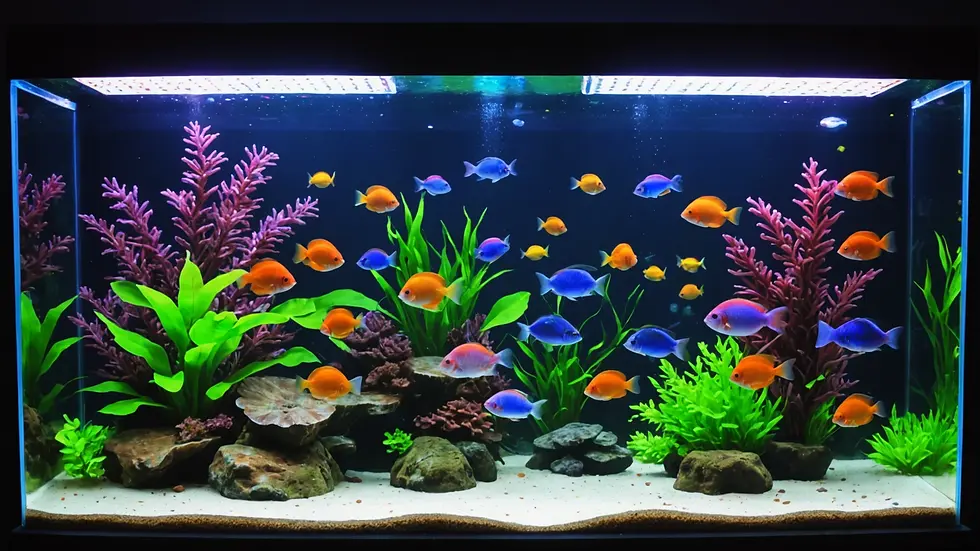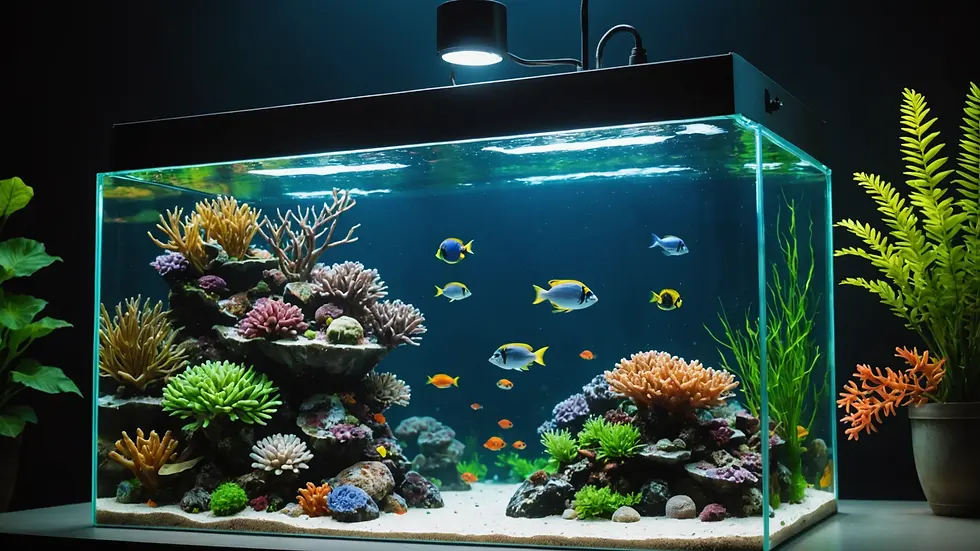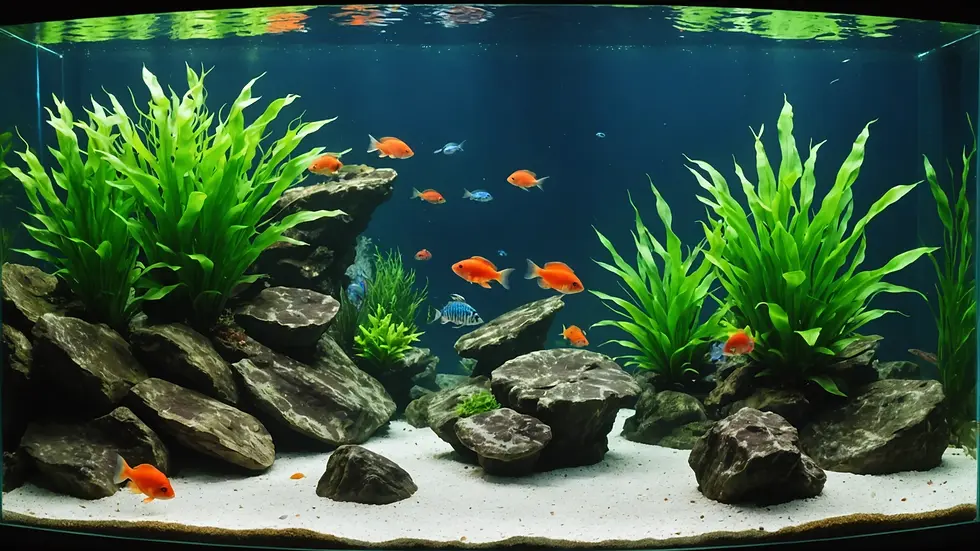Finding the Perfect Illumination: A Guide to Aquarium Lighting
- Jyotiraj Borah
- Feb 6
- 5 min read
Creating the ideal aquarium is not solely about selecting the right fish and plants. A key factor that significantly influences the health, behavior, and aesthetics of your underwater environment is the lighting. Proper illumination sets the mood and promotes the well-being of your aquatic life. This guide will walk you through the various types of aquarium lighting, their benefits, and helpful tips for selecting the right option for your aquatic habitat.
Understanding Aquarium Lighting
Aquarium lighting serves several important functions. It enhances the visual attraction of your tank, provides essential light for aquatic plants, and supports the overall aquatic ecosystem. Natural sunlight can be beneficial, but it is often unpredictable and difficult to control. This is where artificial lighting comes into play. Picking the right illumination not only complements your aquarium's look but also meets the needs of its inhabitants.
When selecting the lighting type, consider the kind of aquarium you have. For instance, freshwater and saltwater tanks may require different lighting solutions than those specifically designed for vibrant plant growth.
Different Types of Aquarium Lighting
Aquarium lighting is available in various types, each with specific benefits and applications. Here are some of the most popular options:
1. LED Lighting
LED lighting has surged in popularity over the last few years due to its energy efficiency. Unlike traditional bulbs, LEDs use up to 75% less energy, which translates to significant savings on your electricity bill. They emit minimal heat, making them a safe option for aquariums. LEDs come in a wide range of colors and intensities, allowing aquarists to create diverse lighting effects.
One remarkable feature of LED lights is their ability to mimic natural day-night cycles, which can enhance the well-being of your fish and plants. For example, using a color spectrum that peaks at blue in the morning and transitions to warmer tones in the evening can positively influence the behavior of certain fish species.

2. T5 Fluorescent Lighting
T5 fluorescent lights are favored for planted tanks, offering a wide range of wattages and lengths to suit different aquarium sizes. These bulbs produce an impressive amount of light, making them ideal for photosynthesis. For instance, T5 bulbs typically deliver 10,000 lumens per bulb, beneficial for robust plant growth.
However, these lights often need more frequent replacement compared to LEDs, typically every 6 to 12 months depending on usage.
3. Metal Halide Lighting
Metal halide lights are renowned for their brightness and are popular in reef tanks to promote coral growth. They provide strong penetration of light, which is critical for deep tanks, often reaching depths of 24 inches or more. However, these lights can generate considerable heat, requiring additional cooling systems to maintain optimal tank temperatures.
While metal halide lights generally consume more energy, resulting in higher electricity costs, they create an attractive shimmering effect on the aquarium's surface, enhancing its appearance.

4. Incandescent Lighting
Incandescent bulbs were once a standard lighting option but have been largely replaced by more efficient alternatives. While they produce a warm light that can enhance fish colors, they are less energy-efficient and generate substantial heat. If you opt for incandescent lighting, keep a constant watch on water temperatures to protect sensitive aquatic life.
5. Specialty Aquarium Lighting
Certain aquariums necessitate specialized lighting, particularly for specific types of corals or deeper tanks. Fixtures with adjustable spectrums can be vital for managing complex ecosystems. Both advanced LED setups and specialized UV or actinic lights are available to support coral growth and health.
Factors to Consider When Choosing Aquarium Lighting
When choosing the right lighting for your aquarium, several important factors come into play:
1. Size of the Tank
The size of your aquarium significantly influences your lighting choice. For larger tanks, multiple light sources may be necessary to ensure even illumination. In contrast, smaller aquariums may only require a single, appropriately sized fixture.
2. Type of Aquatic Life
The species of fish, plants, and corals in your aquarium will impact your lighting decision. For example, if you keep low-light plants like Java Fern or Anubias, high-intensity lights could lead to excessive algae growth. Researching the specific lighting needs of your aquatic life will guide you toward making the right decisions.
3. Light Spectrum
Different aquatic organisms thrive under various light spectrums. Plants generally benefit from blue and red spectrums, while corals require a broader spectrum. Some LED lights allow you to adjust the spectrum, which can help create a balanced environment.
4. Day-Night Cycle
Simulating a natural day-night cycle is essential for the health of your aquatic life. Aim for 10 to 12 hours of light per day to encourage plant growth without stressing fish. Investing in a timer to schedule lighting can help you maintain consistency.
5. Energy Efficiency
Choosing energy-efficient lighting, like LEDs, will save you money over time on electricity and reduce replacement frequency. LEDs, for example, can last up to 15 years depending on usage.
Common Mistakes to Avoid
Being aware of common pitfalls can enhance your aquarium lighting setup. Here are some mistakes to avoid:
1. Overlighting or Underlighting
Excessive lighting can cause rampant algae growth and stress fish. Conversely, insufficient lighting can stunt plant growth. It's important to use the right wattage and duration to match your tank size and type.
2. Ignoring Heat Production
Certain lighting systems, especially metal halides, generate considerable heat. Always monitor water temperatures to ensure they remain suitable for your aquatic inhabitants. Maintaining an average temperature of 75-80 degrees Fahrenheit is ideal for many species.
3. Not Researching Lighting Needs
Before making a lighting purchase, research the specific lighting needs of your intended fish and plants. Each species may have unique requirements that, if not met, could affect their health.
Keeping Your Lighting in Top Shape
To maintain optimal performance from your aquarium lighting, regular upkeep is essential. Here are some effective tips:
1. Clean Light Fixtures Regularly
Over time, algae, dust, and grime can build up on light fixtures, hindering performance. Use a damp cloth to clean the surfaces of your lighting units periodically to ensure maximum light output.
2. Replace Bulbs as Needed
Follow the manufacturer's guidelines for bulb replacement. Even if the lights are still functioning, fluorescent and metal halide bulbs can lose intensity over time and may not provide sufficient lighting for your aquarium.
3. Monitor Performance
Observe the health of your plants and fish. If you notice any decline or an algae explosion, consider reassessing your lighting design and routine.
Enhancing Your Aquarium Experience
Selecting the right lighting for your aquarium is crucial for creating a vibrant aquatic ecosystem. Whether you choose energy-efficient LEDs, powerful metal halides, or versatile T5 fluorescents, understanding your tank's unique needs will ensure a thriving environment for fish and plants.
By carefully evaluating lighting options and regularly maintaining your setup, you can create a stunning and vibrant centerpiece in your home. A well-lit aquarium not only provides beauty but also contributes to the health and happiness of its inhabitants. Enjoy the journey of fish-keeping!





Comments